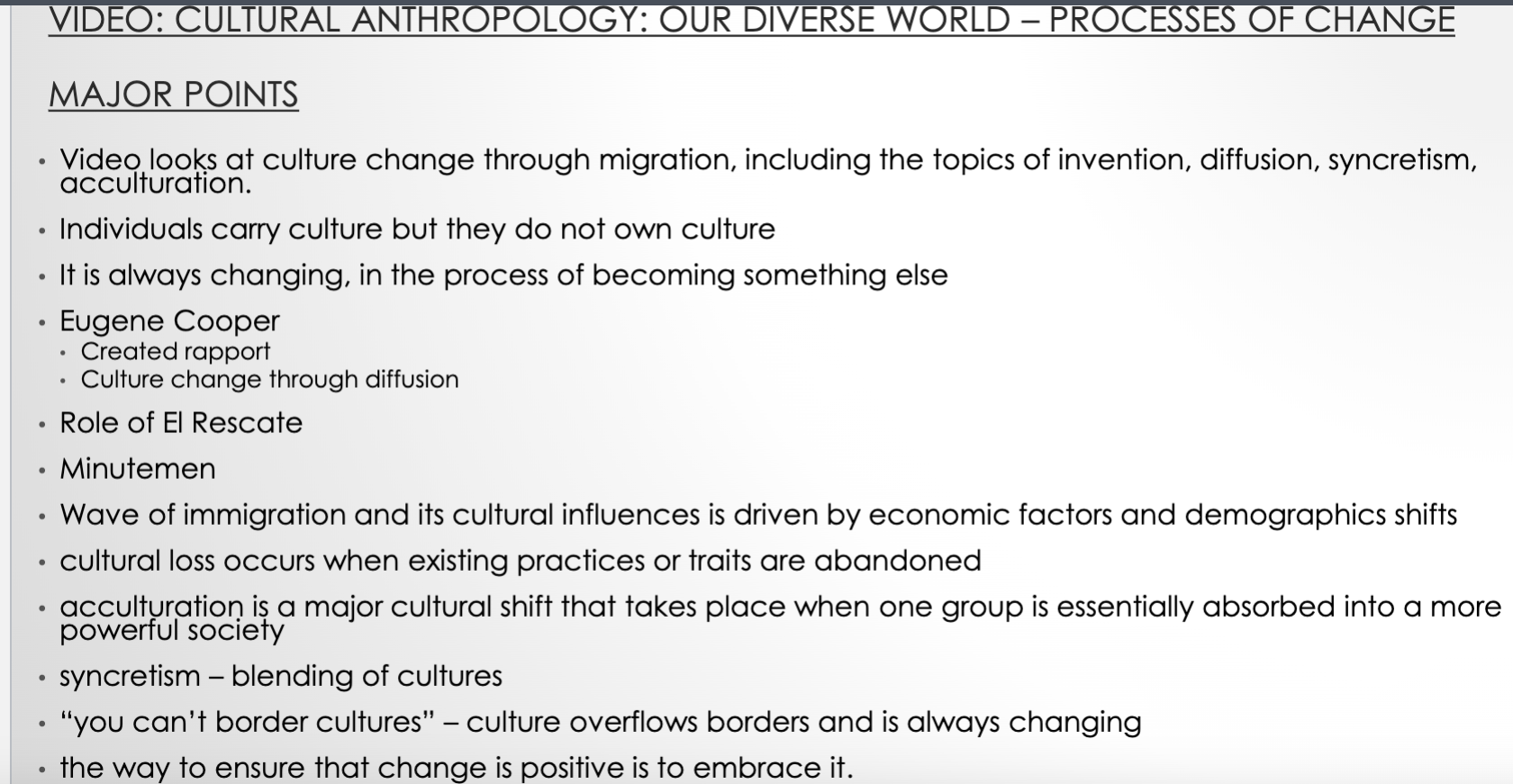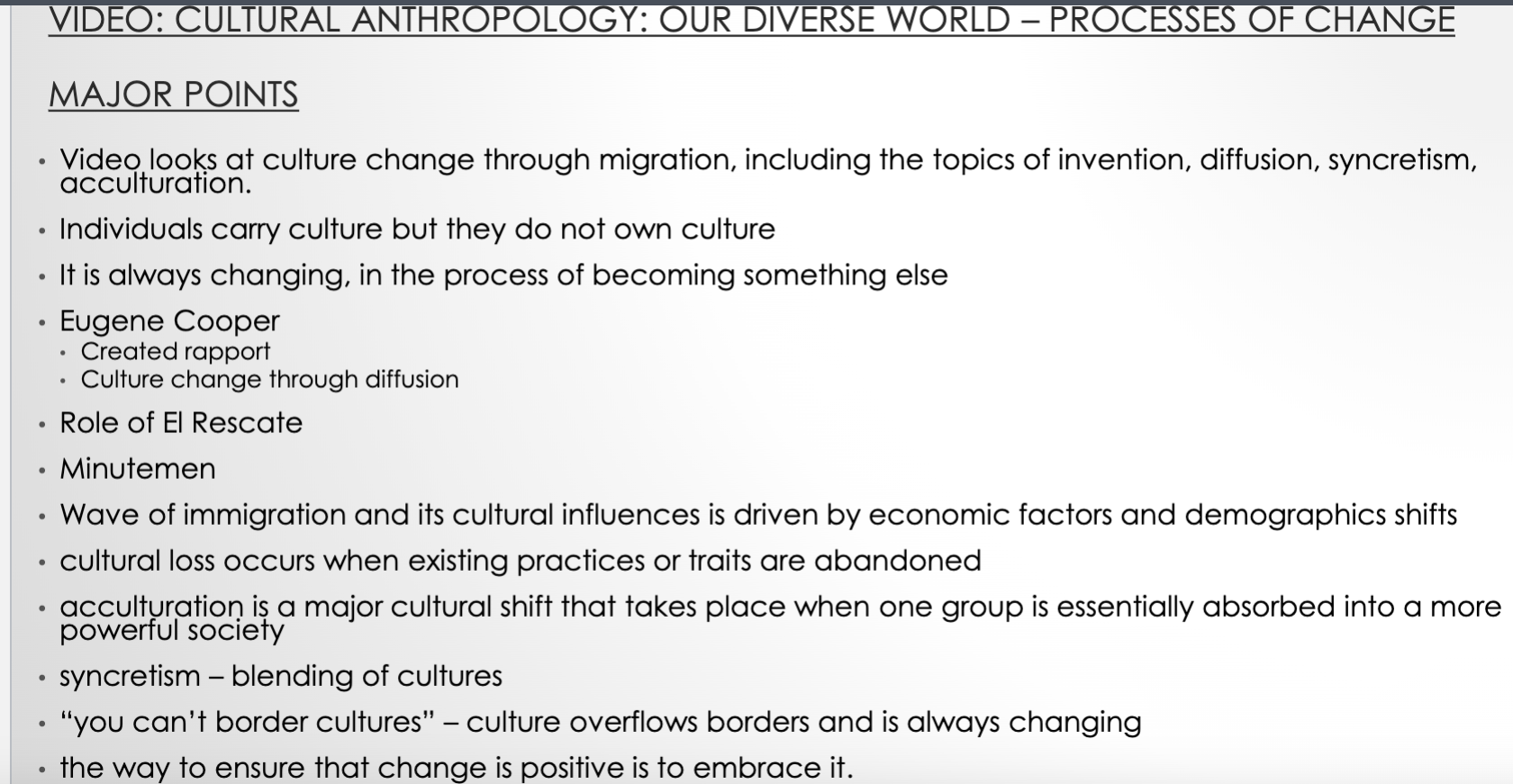ANTH 111 - Cultural Anthropology - Topic 12: Processes of Change, Migration, Multiculturalism, Globalization and Colonialism
1/66
There's no tags or description
Looks like no tags are added yet.
Name | Mastery | Learn | Test | Matching | Spaced |
|---|
No study sessions yet.
67 Terms
What is globalization?
The worldwide intensification and increased movement of money, people, good and ideas within and across borders.
What is the result of global encounters on local cultures?
Hybridization (The blending and mixing of cultural elements, practices, and identities that occur when different cultures interact)
How is global cultural exchange is influenced by power both internally and externally?
Internally — inventions/innovations
Externally — cultural diffusion (spreading of a trait)
How was anthropology ‘born’?
Born out of a moment of globalization through colonization in the mid-nineteenth centry.
What is colonialism?
The practice by which states extend political, economic, and military power beyond their own borders over an extended period of time to secure access to raw materials, cheap labor, and markets in other countries or regions.
What did colonialism and globalization create?
It created a worldwide system of interconnected nation-states.
Commercial
Expansion of economic and cultural influences
Desire to create wealth and spread Christianity
What is the triangle trade?
The extensive exchange of enslaved people, sugar, cotton and furs between Europe, Africa and the Americas that transformed economic, political and social life on both sides of the Atlantic.
It simultaneously brought Western Europeans the resources they needed to grow their national economies and expand their role in international trade. They also established themselves well in political, economic and social systems in Africa and the Americas.
EFFECT:
funded Europe’s transition to machine-based manufacturing —> Industrial Revolution
RESULT:
Industrialized countries racing throughout the nineteenth and
twentieth centuries to divide nonindustrial regions of the world into colonies to
secure their economic growth.
What are the goals of colonialism?
To exploit local economic resources to drive the Industrial Revolution —> colonies of exploitation
To gain maritime areas and control trade —> maritime colonies
To establish settlement colonies where large numbers of settlers displaced Indigenous groups through warfare, disease or murder —> settlement colonies
What did the end of colonial rule bring?
Poverty (to certain countries)
High rates of unemployment
Substances abuse
Political corruption
Etc.
Who were colonial inventions?
Whole countries, along with social groups and divisions within them.
Who became colonial constructions?
Hundreds of ethnic groups and '“tribes” in Africa
What are postcolonial studies?
Focus on the past and present interactions between European nations and the societies they colonized.
What are settler countries?
Large numbers of colonists and scattered native populations.
Examples: Canada, the United States, Australia, New Zealand, and Israel
What are non settler countries?
Large native populations and a small number of Europeans.
Examples: India under British rule
What are mixed countries?
Sizable native and European populations —> balance of both.
What are the 2 major theories on how the contemporary world become so uneven in terms of economic development?
Modernization Theory
World Systems Theory
What are modernization theories?
Post-World War II economic theories that predicted that with the end of colonialism, less-developed countries would follow the same trajectory towards modernization as the industrialized countries.
What is development?
Post-World War II strategy of wealthy nations to spur global economic growth, alleviate poverty and raise living standards through strategic investment in national economies of former colonies.
What is the dependency theory?
A critique of modernization theory arguing that despite the end of colonialism, the underlying economic relations of the modern world economic system has not changed.
What is neocolonialism?
A continued pattern of unequal economic relations between former colonial states and former colonies despite the formal end of colonial political and military control.
What is underdevelopment?
The term uses to suggest that poor countries are poor as a result of their relationship to an unbalanced global economic system.
What is the World Systems Theory?
Also known as “modern world system analysis”. Its the idea that the nations of the world are connected in a systematic political and economic network of exchange whereby the wealthy nations exploit the poorer ones. basically dividing the world between a dominant “core” and a dependent “periphery” (less developed).
What is the “core”?
Countries that industrialized former colonial states that dominate the world economic system. Today, they increasingly rely on the periphery and semiperiphery nations for immigration of cheap labor and outsourcing of certain service jobs.
Examples: Canada, Australia, Japan, Germany, US
What are semi periphery countries?
Nations ranking in between core and periphery countries, with some attributes of the core countries but with less of a central role in the global economy.
Examples: Argentina, China, India, Brazil, Mexico
What are periphery countries?
The least developed and least powerful nations; often exploited by the core countries as sources of raw materials, cheap labor, and markets.
Examples: Bangladesh, Indonesia, Haiti
How do anthropologists contribute to world systems studies?
They ask the question” How has this world systems affected the Indigenous Peoples and cultural systems of the periphery?
How is the world system today?
Spread of industrialization continues.
Nations have shifted positions within the world system.
Twentieth-century industrialization added hundreds of new industries and millions of new jobs.
Mass production gave rise to a culture of consumption.
Young people are abandoning traditional subsistence pursuits, but paying work is scarce, spurring migration.
Employment opportunities have tightened even in core nations such as the United States.
What are MNCs?
It stands for Multinational Corporations. They play a defining role in the spread, effects and impacts of globalization.
What are examples of MNCs?
Walmart, PepsiCo, Apple
What is structural power?
Power that systematically influences political and economic decision making and thus shapes value, ideologies and economies (and culture).
How do MNCs use structural power?
Negotiate with any supplier that is willing to meet the company’s strict demands for quickly made, low cost products
Make agreements with governments that have the lowest environmental and labour regulations
What is a key feature in the changing scale of globalization?
The mobility of people.
What is migration?
The movement of a person or people from one place to another
Often has a profound impact on a person’s economic and social status, health, language, religious identity, and education
Creates a diaspora
What is diaspora?
The dispersion of a group of people from their original homeland. Shows that culture isn’t bound to one geographic location.
What is remittance?
Money that is sent to their homeland to support their families.
What are pushes and pulls?
The forces that spur migration from the country of origin and draw immigrants to a particular new destination country.
What are some examples of push factors?
War
Political instability
Famine
Drought
What are some examples of pull factors?
Political stability
Job opportunities
Natural resources
Better education
Better climate
What are bridges and barriers?
The factors that enable or inhibit migration.
What are some examples of bridges?
Family networks,
Transportation links,
Government immigration policies,
Recruitment agencies
Human smugglers
What are some examples of barriers?
Language difference
Geographical distance to tightly regulated borders
Expenditures (expenses) for passports, visas, and transportation
What are some global migration patterns?
Different countries are affected differently by today’s global flow of migrants—some are primarily sending countries while others are primarily receiving countries.
Migration also occurs internally, often from a country’s rural areas to its urban areas.
What does a true global perspective include?
Both international and internal migration.
What are labor immigrants?
Persons who move in search of low-skill and low-wage jobs, often filling an economic niche that native-born workers will not fill
What are some examples of labor immigrants?
Nurses
Carpenters
Harvesters
What is circular migration?
Type of labour migration where there is a regular pattern of population movement between two or more places. May occur within or between countries.
What are some examples of circular migration?
Migrant farm workers —> seasonal
Domestic workers in Latin America
What are refugees?
Persons who have been forced to move beyond their national borders because of political or religious persecution, armed conflict, or disasters.
16 million or 1 out of 500 are refugees.
What are some statistics about refugees?
According to UNHCR (United Nations High Commissioner
for Refugees) estimated 13.4 million Syrians have fled their
homes since 2011 with 6.6 million of those fleeing the
country.
Over 742,000 Rohingya have fled to Bangladesh
3.5 million have left Ukraine, 2 million internally displaced
What are internally displaced persons (IDPs)?
Similar to international refugees, but within a migrant’s own country. It does not come under the jurisdiction of the UN. They live in camps for extended periods.
Which continent has the most IDPs?
Africa, especially Sudan
Which other countries have a rise of IDPs?
Iraq, Syria
Eastern Ukraine
What are some factors of IDPs?
Political violence
Natural disasters
Large scale developments
What is development induced displacement?
The involuntary displacement of people from their homes or habitual residences to make way for development projects.
What are examples of development induced displacement?
Mega dams (affect massive areas of land and HUGE numbers of people)
Dam projects along have displaced 80 million people
• Three Gorges Dam, spanning the Yangtze River, China
—>Displacement of 1.3 million people
What are key factors that ease or increase relocation stresses?
Extent that new location resembles old
Climate, language, food
More difference = more stress
Ability to obtain work
Presence of family
Level of welcome or hostility in new home
What is the ‘in-between generation’?
Individuals who are a part of ‘2 worlds"‘. They communicate both with their parents and communicating for parents.
How is multiculturalism in Canada?
34 ethnic groups with at least 100,000 members
Over 19% of the population is visible minorities
What does it mean to be a “new immigrant”?
Newcomer to a new country. This includes refugees.
What are 3 trends that characterize the new international migration?
Globalization
More countries involved
Acceleration
Growth in numbers
Feminization
Women growing percentage
What is chain migration?
First wave attracts family and friends.
What is family reunification?
Bringing together family members living in different countries.
What do migration policies include?
Determining who is welcome (included), how many, and how they are
treated is largely dictated by political and economic interests.
What is the lifeboat mentality?
A view that seeks to limit enlarging a particular group because of perceived constraints on resources
Do you see this in the world around you? U.S.?
As economic problems persist, so does the lifeboat mentality
What are some concerns with migration and human rights?
Is migration forced or voluntary?
Forced migration – a violation of human rights?
Do members of a displaced group have the right of
return?
A refugee’s entitlement to return to and live in his or her homeland.
Is a basic human right in the West
Internal displacement and loss of rights
New Orleans
Differential resettlement
What is differential resettlement?
Unequal or discriminatory approaches to refugee resettlement based on factors like nationality, ethnicity, or other characteristics.

